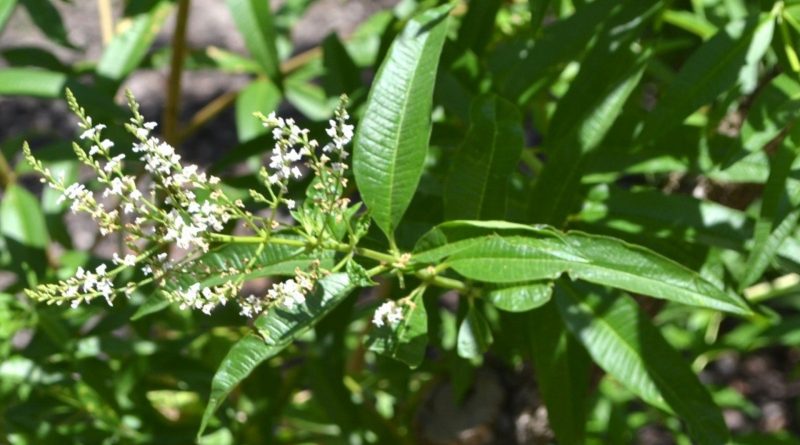Aloysia citriodora
Aloysia citriodora
Lemon verbena (Aloysia citriodora Palau) is a perennial shrub species belonging to the Verbenaceae family.
Systematics –
From the systematic point of view it belongs to the Eukaryota Domain, United Plantae, Magnoliophyta Division, Magnoliopsida Class, Lamiales Order, Verbenaceae Family and therefore to the Genus Aloysia and to the A. citrodora Species.
The terms are synonymous: Aloysia sleumeri Moldenke, Aloysia triphylla (L’Hér.) Britton, Cordia microcephala Willd. ex Roem. & Schult., Lippia citriodora (Palau) Kunth, Lippia triphylla (L’Hér.) Kuntze, Verbena citriodora (Palau) Cav., Verbena triphylla L’Hér. And Zappania citrodora (Palau) Lam ..
Etymology –
The term Aloysia is the Latinization of the names Luigia / Luisa / Louisa: genus dedicated by P. Palau to Queen Maria Louisa of Bourbon Parma, Queen of Spain (1751-1819), wife of her cousin Charles IV. The specific epithet citriodora comes from citrus cedar, lemon and odorous, fragrant: with flowers or leaves that smell of citrus fruits.
Geographical Distribution and Habitat –
Lemon verbena is a plant native to South America where it grows in the wild in Ecuador, Peru, Chile and Argentina; from these countries the plant was imported into Europe by the Spaniards in the 18th century to be used in the perfume industry.
Description –
Aloysia citriodora is a deciduous shrub that can reach a height of about 2.5 meters.
It has a woody stem, with sessile leaves, gathered in 3-4 whorls; these are green, rough above, lanceolate, which have an intense aroma and taste of lemon.
The small flowers are gathered in terminal panicles, of a white-violet color and have a slight lemon flavor.
Cultivation –
For the cultivation of the Lemon verbena it is taken into account that it is a plant that does not tolerate low winter temperatures below 0 ° C. In these areas the plant should be cultivated in pots that should be placed in sunny areas during the summer and in a protected place during cold periods.
To sow the plant, choose places sheltered from the wind and with minimum temperatures of 15 ° C; the emergence of the young seedlings, in these conditions, occurs after about 20 days.
When the seedlings are developed they can be transplanted into small jars, using a mixture of garden soil and coarse sand.
Especially in colder climates it is advisable to cultivate young seedlings in pots for two years before planting.
The plant can be reproduced more easily by cuttings by taking portions of the stem in the late spring or summer period, making them root in an earthy substrate in shaded areas. In spring, cut the stems where the new vegetation is forming. For pruning it is advisable to intervene at the end of the summer with moderation to eliminate dead heads.
Uses and Traditions –
Aloysia citriodora, as well as with the more commonly used name of Lemon verbena, is known by the common names of citron, limoncina, citronella, Luigia grass, Luisa herb, Maria Luigia grass, perseghina herb, limonetto, lippia, Aloisio and piscella grass.
From the leaves of this plant an essential oil is extracted, used in the cosmetic industry, rich in volatile compounds such as geraniol, citral and limonene. Both the leaves and the dried flowers can be used to perfume cabinets and rooms.
In the herbal sector it is used for the preparation of herbal teas, infusions and packs. It is used in the kitchen to make liqueurs, jams, fruit salads and as a spice. However, prolonged use may cause stomach upset, including gastritis.
The infusion is used as a digestive, carminative and antispasmodic, in case of stomach pains or indigestion. It is also consumed as a mild sedative.
The plant has therapeutic properties: antineuralgic, neurotonic, stimulants.
This plant contains significant amounts of melatonin, a substance used as a natural relaxant that promotes sleep at night. The elements used in infusion are collected twice a year, in late spring and early autumn. Young leaves and flowering tops are used.
It is advisable, in general, to harvest the leaves in summer when the plant is in bloom and dry them in a cool, shady place. We recommend keeping the dried leaves in a glass jar as they will retain their scent for at least three years.
Preparation Mode –
Lemon verbena is used for its fresh or dried leaves which are used to prepare infusions or herbal liqueurs, to flavor oil and vinegar or jams, fruit salads, jellies or ice creams.
Guido Bissanti
Sources
– Acta Plantarum – Flora of the Italian Regions.
– Wikipedia, the free encyclopedia.
– Treben M., 2000. Health from the Pharmacy of the Lord, Advice and experiences with medicinal herbs, Ennsthaler Editore
– Pignatti S., 1982. Flora of Italy, Edagricole, Bologna.
– Conti F., Abbate G., Alessandrini A., Blasi C. (edited by), 2005. An annotated checklist of the Italian vascular flora, Palombi Editore.
Attention: Pharmaceutical applications and food uses are indicated for informational purposes only, do not in any way represent a medical prescription; therefore no responsibility is assumed for their use for curative, aesthetic or food purposes.


